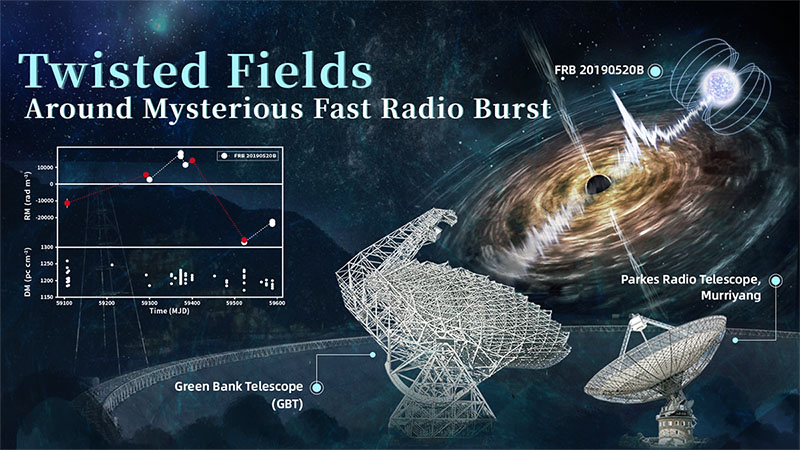| May 12, 2023 |
Astronomers discover twisted fields around mysterious fast radio burst
|
|
(Nanowerk News) Fast Radio Bursts (FRBs), characterized as the most luminous millisecond-duration celestial detonations within the radio spectrum, have long presented perplexing questions to the realms of astronomy and physics due to their enigmatic origin.
|
|
The Commensal Radio Astronomy FAST Survey (CRAFTS), a seminal program of the Five-hundred-meter Spherical radio Telescope (FAST), has made a groundbreaking discovery: the first ever continuously active repeating FRB, designated as FRB 20190520B. This unique FRB has shed light on potential leads that may elucidate the origins of these phenomena.
|
|
An international consortium, spearheaded by Dr. LI Di of the National Astronomical Observatories of the Chinese Academy of Sciences (NAOC), undertook an observational campaign of FRB 20190520B. This endeavor, leveraging the capabilities of the Parkes telescope in Australia and the Green Bank Telescope (GBT) in the United States, unveiled an extreme magnetic field inversion surrounding this perpetually bursting source.
|
|
This multinational, collaborative research effort was featured in Science ("Magnetic field reversal in the turbulent environment around a repeating fast radio burst").
|
 |
| Twisted fields around a mysterious fast radio burst. (Image LI Di/ScienceApe/CAS) (click on image to enlarge)
|
|
In contrast to its counterparts, FRB 20190520B uniquely generates bursts that are invariably detectable by at least one, and often multiple, telescopes during each observation. This unfailing repeatability renders it an optimal candidate for comprehensive multiband follow-up studies.
|
|
"A staggering total of 113 bursts from FRB 20190520B were detected by the Parkes telescope, surpassing the cumulative number of fast radio bursts previously discovered at Parkes, thereby underscoring the extraordinary significance of FRB 20190520B," remarked Dr. DAI Shi from Western Sydney University, the Principal Investigator of the FRB 20190520B project at Parkes.
|
|
Through a joint analysis of data collected from GBT and Parkes, Dr. FENG Yi, a NAOC alum now at Zhejiang Laboratory, and Ms. Anna-Thomas from West Virginia University (WVU), gauged its polarization attributes. They discovered that the Faraday rotation measure (RM) underwent radical sign alternations: oscillating from approximately 10,000 units to -10,000 units, and reciprocally. Other crucial contributors include Dr. Liam Connor from Caltech and Dr. Sarah Burke-Spolaor from WVU.
|
|
During the trajectory of a burst signal, the polarization properties can be influenced by the enveloping plasma. "The RM can be approximated by the integral product of magnetic field and electron density. Although fluctuations in RM can be attributable to either factor, a sign change must stem from the reversal of magnetic fields, as the electron density cannot assume negative values," explained Dr. LI Di, the corresponding author of the study.
|
|
This inversion might be the consequence of the signal traversing a turbulent, magnetized plasma screen situated within 10-5 to 100 parsecs of the FRB source. "The turbulent components of the magnetic field surrounding repeating fast radio bursts may resemble a chaotic ball of wool," opined Prof. YANG Yuanpei from Yunnan University, a co-author of the study.
|
|
A plausible explanation for this disarray could be the signal crossing the halo of a companion entity, such as a blackhole or a massive star with winds. Gaining insights into these severe alterations in the magnetized environment surrounding the FRB is a crucial stride toward comprehending the origins of such cosmic detonations.
|

